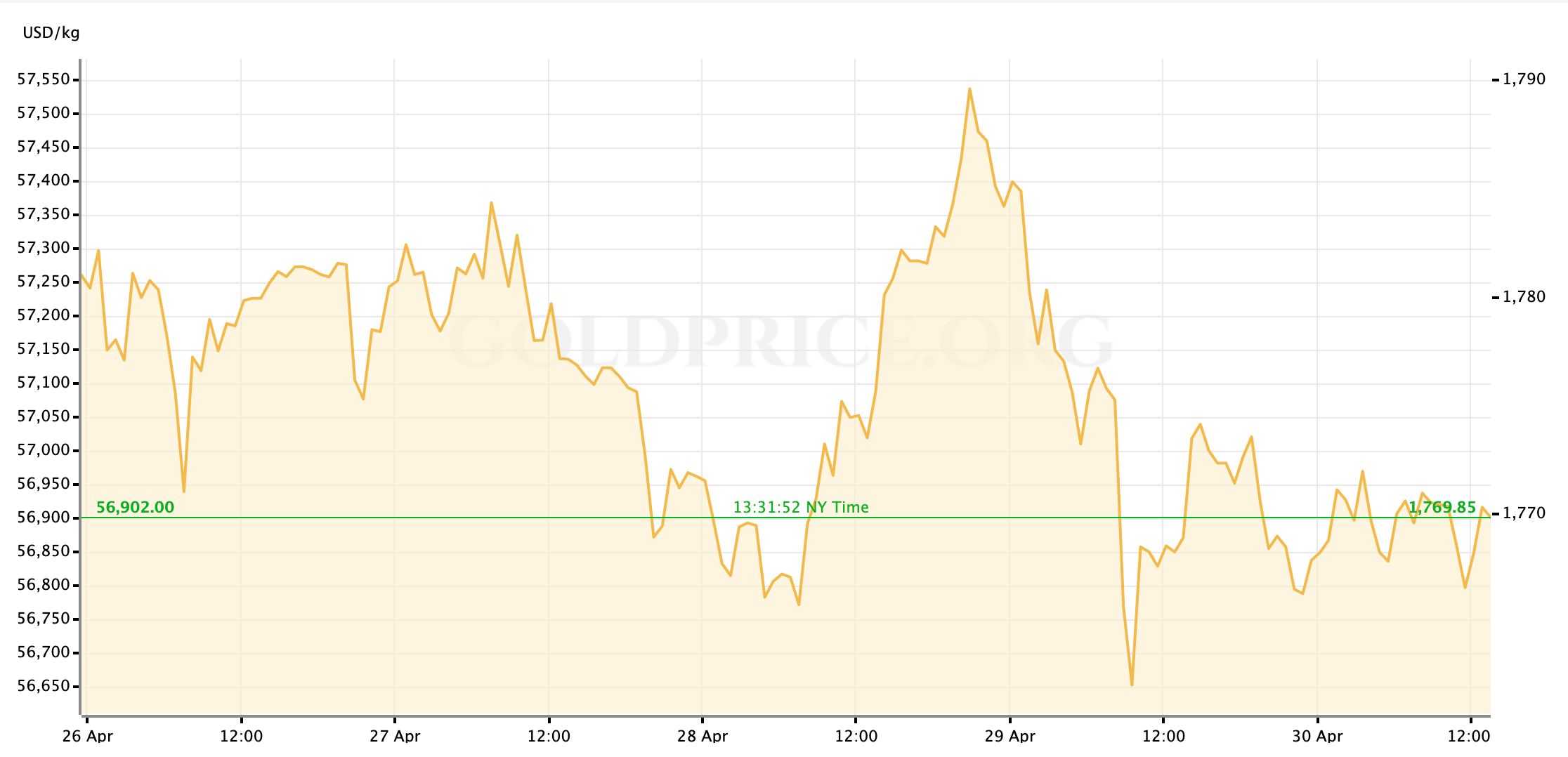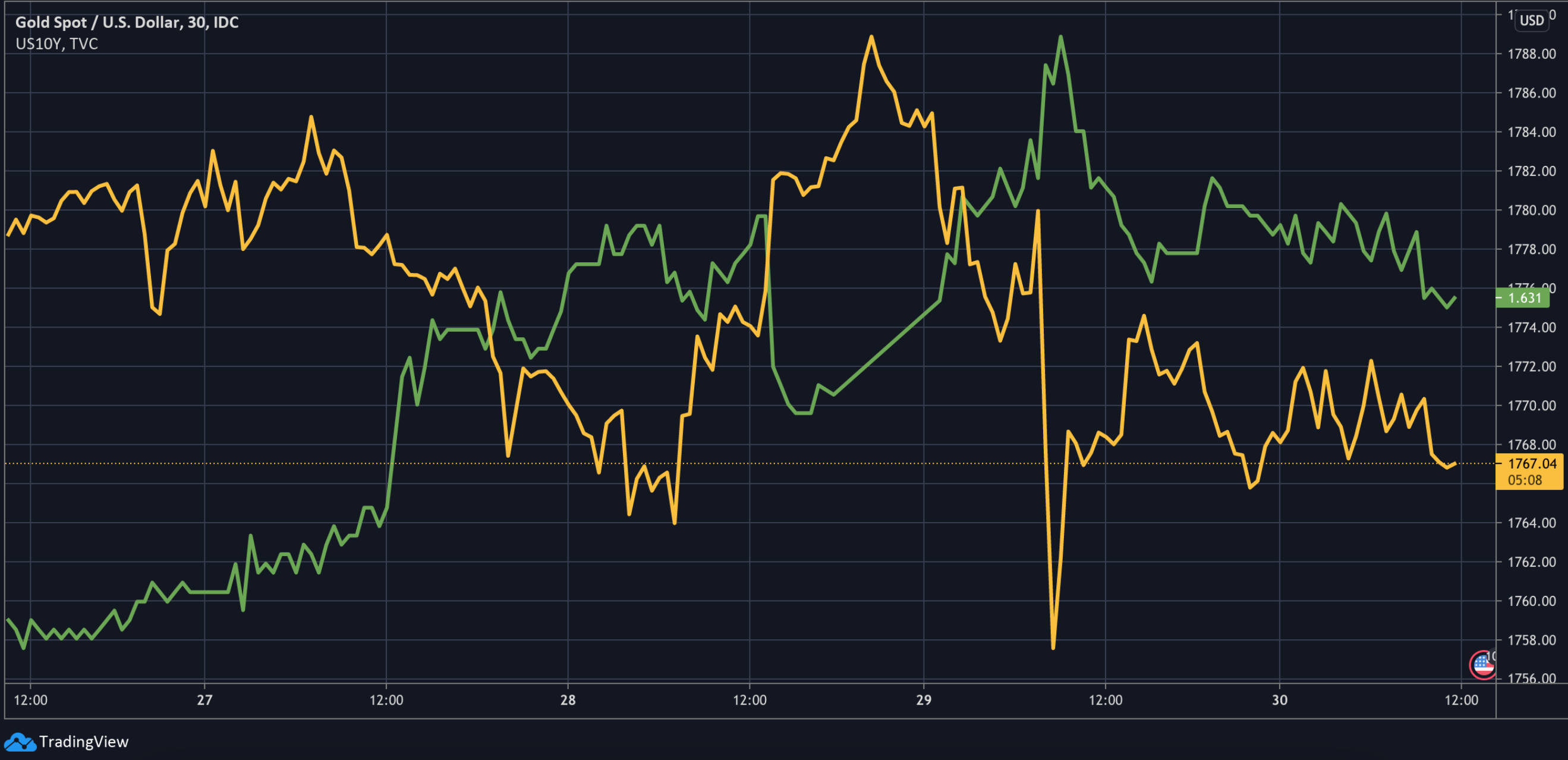Happy Friday, traders. Welcome to our weekly market wrap, where we take a look back at these last five trading days with a focus on the market news, economic data and headlines that had the most impact on gold prices—and may continue to into the future—as well as the charts for silver, the US Dollar and other key correlated assets.
Gold prices are moderately lower—but looking reliable for the month ahead—at the tail end of this trading week, after five days of relatively subdued trading, with the exception of a strong mid-week rally and a pair of sharp squeezes lower.

So, what kind of week has it been?
After a stretch of calm to begin Q2, a more reactive US Treasuries market was once again the most impactful counterpart for gold prices this week. We aren’t seeing the wild runs of short selling in sovereign debt that caused market havoc several times in February and March, but when looking at US 10-year Note’s yield at the same time as gold was making its biggest gains or losses this week the correlation is clear.
- After a mild Monday start to the trading week, bond yields (and projected interest rates) began to move, probably in anticipation of President Biden’s mid-week address to Congress, in which he would roll out the third in a series of massive fiscal spending packages designed to buoy the US recovery, and to support and modernize the US economy and its labor market.
- While not as active of enthusiastic, with progressively strong signals of economic recovery and growth having been reported in recent weeks and anticipated to continue, it’s reasonable to assume that inflation hawks—who suspect that a heated US recovery may force the Fed to raise interest well before currently implied—were also involved in some degree in the surges of bond-selling we saw at times this week.

With a lineup of very strong earnings reports from some of the US stock market’s biggest whales rolling out on Tuesday and a reported surge in consumer confidence, the 10-year’s yield began climbing on Tuesday, surpassing 1.6% for the first time in a week. These indicators of a strengthening US economic recovery exacerbated the trend in investors’ positioning ahead of President Biden’s address.
- The move higher in yields (and a corresponding strengthening of the US Dollar) brought pressure to the gold chart, and precious metals’ spot prices fell steadily throughout Tuesday’s session and into the Asian and European sessions.
- The pattern repeated in the morning hours of Thursday’s session, thanks to another boost to (possible) inflation expectations when the first pass at calculating growth in the US economy for Q1 of 2021 returned a very strong year-over-year increase (as expected,) and the 4-week average of new jobless claims continued to fall towards 600K.
- This second rally in Treasury yields, which looked briefly as if it might push the 10-year’s rate back above 1.7%, heaped even great acute pressure on gold and sent the yellow metal down its biggest slide of the week before demonstrating support around $1760/oz.
In between the two troughs for gold’s chart this week, prices made their biggest gains on Wednesday (once again) thanks to Jerome Powell and the Fed continuing to hold their ground. While the Chairman and the committee acknowledged the strong improvements to the US economy since Coivd-19 vaccinations became widely available, they still insist that “It’s not close to substantial further progress” that would warrant even discussing a taper of the Fed’s massive bond-purchasing program or hiking interest rates.
- Although US equities weren’t full participants in the Wednesday afternoon swing, the FOMC’s statement and Chairman Powell’s subsequent Q&A kicked the reflation trade back into high gear for gold, silver and other raw commodities: Gold spot prices rebounded to the $1780/oz level while Powell held his regular press conference, and higher just as the Asian trading session reopened.
- The lackluster day for equities was indicative of much this week, in which stocks seemed to tip generally positive, but with less of the enthusiasm that has characterized the re-opening/reflation trade in recent week.
After rebounding from Thursday morning’s steep losses, gold has stabilized and looked strong over the last 24 hours, consolidating near $1770/oz. So, although the price reflects a moderate step backwards for gold this week, prices may be primed to move back towards $1800/oz next week: The start of May’s economic calendar is expected to continue the trend of indicating strong/accelerating growth in the US, and Fed officials will likely spend their post-meeting public appearances reiterating their intention to keep the party going for a while.
- The biggest question looking toward next week, for me, is what kind of impact the Treasuries market will have on gold’s momentum (or lack of it.) For much of April, we saw very strong US economic data without stirring up higher yields and my hunch is that we’ll see that again next week because the news calendar won’t be built around the specific driver that was the US President asking for the next trillion Dollars.
- It’s also a benefit to gold’s outlook, I think, that equities were rather muted this week. It suggests that the re-opening/reflation trade could get back up to full-speed next week for both “riskier” equities and safe-haven commodities like gold; And that the possible inflection—at which point the stock market accelerates to quickly for investors to pay attention to gold—is pushed farther out on the curve.
- Talking a quick look at the main data points on for next week:
- The main event will be Friday’s release of the April Jobs Report, which we can assume from recent weekly labor market data will be another door-buster.
- Before that, I expect investors will also be excited to see the primary metrics for activity growth in the US’ manufacturing and services sectors carry on from historically strong March numbers. Manufacturing and service-sector PMI will be released Monday and Wednesday, respectively.
For now, traders, I hope you can get out and safely enjoy your weekend for the next couple of days. After that, I’ll see everyone back here on Monday for our preview of the week ahead.













